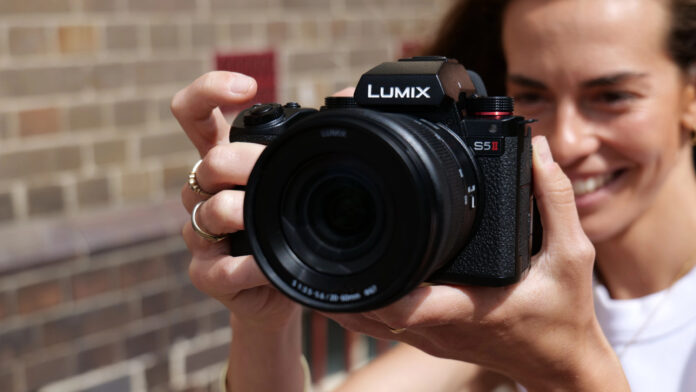In videography, small details can make a big difference. Even slight camera shake can ruin the perfect shot. If you’ve zoomed in closely or attempted to film in poor light conditions, you’ve likely noticed that the more you zoom in, the shakier your footage becomes. While some production styles may incorporate a bit of shake, generally speaking, steady and stable video looks the best. Achieving great image stabilization can be done in various ways, but one of the most effective methods is investing in a camera with in-body image stabilization (IBIS), such as the Panasonic LUMIX S5II and LUMIX S5IIX.
Both the Panasonic LUMIX S5II and LUMIX S5IIX boast innovative IBIS systems that simplify capturing steady shots. How does it work? Let’s explore the inner workings of these cameras’ IBIS systems and talk about how they can help you capture the best image possible.
Image stabilization explained
There are various ways to achieve image stabilization, such as external stabilization with tools like a gimbal or digital stabilization, where a computer processes the image to compensate for camera shake. While external stabilization can help you capture incredibly stable shots, it might drive up your production costs. Digital stabilization can be cost-effective but doesn’t cover all five axes of movement the way that IBIS does. For instance, digital stabilization can correct shakes in the X and Y axes but struggles with more complex rotational movements.
That’s where IBIS comes in. This system uses sensors to detect movement, a processor to interpret the movement, and motors to shift the sensor or part of the lens to compensate for it. Cameras like the Panasonic LUMIX S5II and LUMIX S5IIX feature 5-axis IBIS, reduce the need for additional gear and stabilize all five axes of movement.
Inside 5-axis IBIS
It’s easy to get stuck thinking only about 2-axis movement: up, down, left and right. But with camera movement, you need to think three-dimensionally. More specifically, you have to consider the five axes of movement: X, Y, Roll, Yaw and Pitch. IBIS actively stabilizes all these axes. This stabilization is accomplished through a camera’s IBIS system’s gyro sensors and internal floating lens elements that detect and instantly correct any shift or tilt along these axes. The result is a camera that moves with you, fluidly mirroring your movements to capture stable footage.
How the LUMIX S5II and LUMIX S5IIX’s IBIS improves your video
Reduced shake and enhanced image quality
While IBIS helps reduce shake and movement, that’s not its only advantage. In photography, the rule of thumb is that you never set your shutter speed slower than your focal length. For example, if you’re using a 50 mm lens, you shouldn’t go below 1/50th of a second on the shutter speed. Otherwise, your image will be blurry. But if your camera has some kind of image stabilization, you can decrease the shutter speed or lower the stops. Video recording is different in terms of shutter speed. It’s normally a fixed number for your entire project, but you will see a cleaner image with a stabilized shot.
Flexibility in usage
Another IBIS advantage is flexibility. If you use an in-lens system, you’re locked into using only one lens. IBIS allows you to change lenses without sacrificing stability. You can also take advantage of a lighter, more compact kit without having to bring additional gear, like a gimbal mount. You’re ready to shoot in various conditions and terrains without relying on bulky equipment. You’re ready to run and gun just about anywhere. Plus, most external mounts require extensive setup time to properly balance the camera, which can change from project to project.
The best times to use IBIS
Utilizing IBIS in handheld and action shots
As you might imagine, IBIS is the first choice in a handheld shooting situation. No matter how steady you think you are, there will always be some movement from your body. IBIS is also ideal for action or moving shots. For example, imagine you want to film alongside your subject as they run on a dirt path. Without some form of stabilization, like IBIS, your recording could be unusable. IBIS helps counteract the natural movements and shakes, capturing smoother and more stable footage.
IBIS in low-light and telephoto situations
When capturing those mesmerizing low-light scenes or zooming in for a detailed shot, stabilization is key. In low light, slower shutter speeds or a wider aperture can make slight movements more apparent. The same is true when you’re using a telephoto lens. The tighter you zoom in, the more unstable the shot looks. Think about when you’re zooming in on something far away, like a bird in a tree or the moon. This can even be true if you have your camera on a tripod. Subtle shakes in the ground or a touch from your hand are magnified with extreme zoom. It’s the same with extreme zoom using a macro lens. You need an extreme close-up, and the camera jitters are magnified. By using IBIS, the camera can actively compensate for these jitters, providing a more stable and clear shot, no matter the conditions.
When to turn off IBIS
Generally, there are situations where you might want to deactivate the IBIS, especially if you’re aiming for specific camera movements. For example, when you’re going for that intentionally unsteady look, you’ll find yourself fighting against the gyros and motors designed to stabilize the image. Additionally, if you’re doing a slow pan, zoom or even a combination of both, IBIS might actually hinder your footage, making your movement appear unnatural. In these instances, understanding when and how to turn off the IBIS allows for more control and creativity in your videography.
What the LUMIX S5II and LUMIX S5IIX’s IBIS systems have to offer
Panasonic’s latest innovations include a new Active Image Stabilization feature that supports walking shots and further enhances video stabilization. These improvements offer about 200 percent better stabilization in Video Mode compared to the original LUMIX S5. This translates to a reliable IBIS system that makes the most of sensor-shift stabilization technology. Both the LUMIX S5II and the LUMIX S5IIX come with dual IS, or two image stabilization systems, that compensate for approximately 6.5 stops of camera shake when taking still images.
In addition to the IBIS technology, both mirrorless cameras boast a full-frame 24.2 MP CMOS sensor and 779-point Phase Hybrid Auto Focus. These features, along with their ability to record in 4:2:0 10-bit 6K and 5.9K, add another layer of control and detail to every shot, enhancing stabilization. The S5IIX, in particular, takes things further, enabling 5.8K Apple ProRes footage to be recorded to an SSD. It also allows for wired or wireless streaming, offering videographers even more flexibility in achieving stable, professional-grade footage.
Using the right camera for the job
If you’re looking to elevate your videos, explore what the LUMIX S5II and LUMIX S5IIX’s IBIS systems have to offer. These aren’t just cameras; they’re tools designed to help you achieve smooth, stable video in various scenarios. Whether you’re shooting a documentary or feature, capturing an action-packed scene, executing an extreme zoom, or focusing on a delicate moment in low light, the IBIS systems in the Panasonic LUMIX S5II and LUMIX S5IIX can help you get the shots you’re aiming for. Learn more about the LUMIX S5II and the LUMIX S5IIX at panasonic.com.








